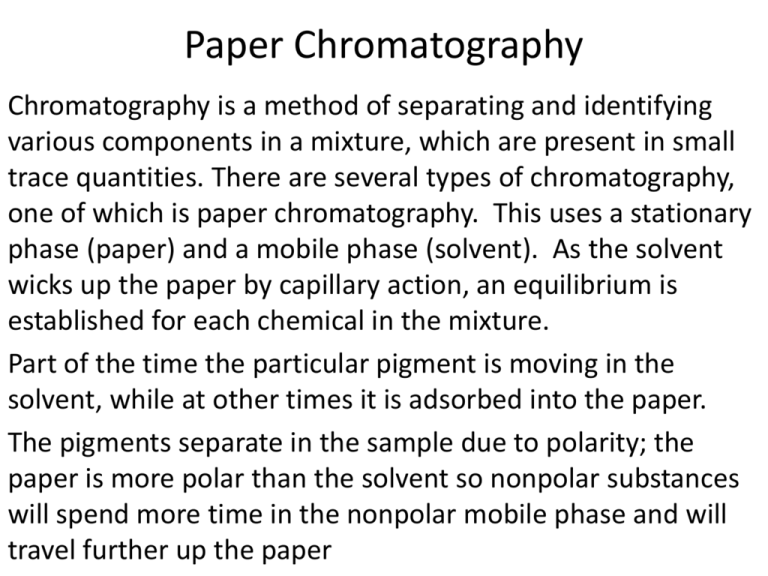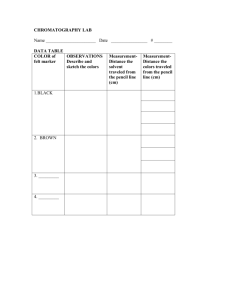Spinach Chromatography - Tanque Verde Unified School District
advertisement

Paper Chromatography Chromatography is a method of separating and identifying various components in a mixture, which are present in small trace quantities. There are several types of chromatography, one of which is paper chromatography. This uses a stationary phase (paper) and a mobile phase (solvent). As the solvent wicks up the paper by capillary action, an equilibrium is established for each chemical in the mixture. Part of the time the particular pigment is moving in the solvent, while at other times it is adsorbed into the paper. The pigments separate in the sample due to polarity; the paper is more polar than the solvent so nonpolar substances will spend more time in the nonpolar mobile phase and will travel further up the paper Spinach Chromatography Lab Objective 1. Separate pigments from spinach using paper chromatography 2. Calculate Rf values of separated pigments *Rf = distance substance travels distance solvent front travels Materials • Chromatography paper strips • Petroleum Ether: Acetone Solution • 1 vial spinach leaf extract • Capillary pipet • Parafilm squares • MSDS • Transparent Tape • Metric rulers • Graduated Cylinder (100mL) • Graphite pencil Pre-lab Questions • What is chromatography? • Calculate the Rf of a substance that traveled 5.2 cm on chromatography paper. The solvent front traveled 8.1 cm. • Does each spot on the developed chromatography paper represent one substance? Procedures 1. 2. 3. 4. 5. Prepare a piece of chromatography paper by measuring 2cm from bottom of paper and drawing a line with pencil At the other end, attach a piece of tape long enough to drop the paper to the bottom of the graduated cylinder and attach the top of the tape to the cylinder mouth At center station, touch the capillary pipet with pigment to center of line; allow the spot to dry Pour 5mL petroleum ether: acetone solution into 100mL graduated cylinder Cover the top of cylinder with Parafilm square 6. Place chromatography paper inside cylinder so that the paper extends into the solvent 7. Wait 10 minutes, then remove the paper from the cylinder, and mark the location of the solvent front with pencil. Trace pigment outlines with pencil after solvent evaporates 8. In your notes, draw a life-size picture of the developed chromatography paper, labeling the locations and colors of the spots. 9. Measure the distance each spot and the solvent front traveled from the pencil line; calculate the Rf values for each pigment. Follow-up Questions • Find the distance traveled by: – – – – – Solvent front _______cm Carotene ________cm Xanthophyll _______cm Chlorophyll a ______cm Chlorophyll b_______cm • Calculate Rf for each pigment: Carotene ________ Xanthophyll _________ Chlorophyll a ________ Chlorophyll b ________ • Which pigment is most polar? Which is least?






